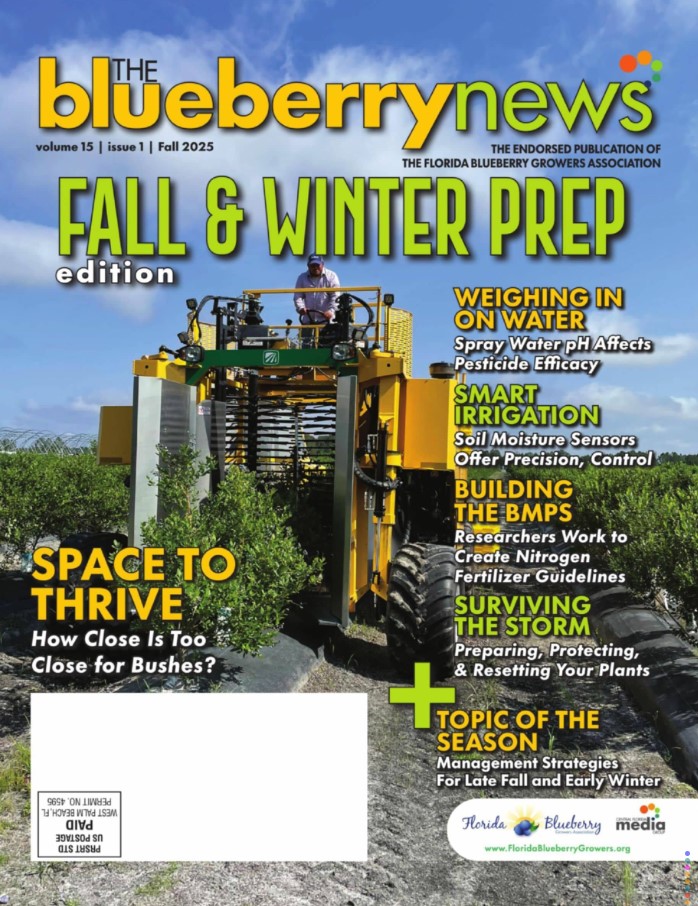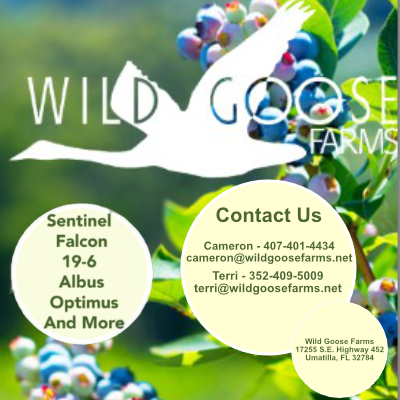- Home
- About Us
- Hall of Fame
- UF/IFAS Blueberry Extension
- Blueberry Fans
- Grower
- Contact Us
VarietiesSouthern HighbushPrimadonna makes a vigorous, upright bush and tends to be more evergreen than Star and Jewel, possibly because it tends to be more resistant to rust than Star and Jewel. It also tends to flower before it makes new leaves, which can be a serious problem if it does not produce enough early leaves to support development of fruit. It is also somewhat susceptible to root rot and stem blight. It requires 300 chill hour units. Emerald is a vigorous bush with a growth habit midway between upright and spreading. Flowers open uniformly and it produces abundant leaves even after mild winters. Emerald is very capable of carrying heavy crops. Berries are large and firm with a good picking scar and have a sweet flavor. Color is medium to dark blue. There are no real problems with Emerald, root rot, stem blight and cane canker have not been too serious.[/important]Emerald is a vigorous bush with a growth habit midway between upright and spreading. Flowers open uniformly and it produces abundant leaves even after mild winters. Emerald is very capable of carrying heavy crops. Berries are large and firm with a good picking scar and have a sweet flavor. Color is medium to dark blue. There are no real problems with Emerald, root rot, stem blight and cane canker have not been too serious. Star is a low chill southern highbush variety that requires 300-600 chill hour units. Star flowers later than Sharpblue, but ripens at the same time. The berries are large and have excellent scar and firmness. The plant is medium in vigor and has a upright growth habit. It is as resistant or better than Sharpblue with root rot, stem blight and leaf fungal diseases. Windsor is an early ripening and early flowering highbush with high yield potential and large berry size. It is very vigorous with stout stems and a semi-spreading growth habit. It may abort some or all of its flower buds after mild winters. Berries have good firmness and flavor, but picking scar is variable. Windsor has above average resistance to leaf-spotting organisms and moderate resistance to root rot. Jewel has a moderately low chill requirement. It is an early ripening and high quality berry. Jewel produces a large number of flower buds but leafs well in the spring. Vigor is about equal to Sharpblue, but Jewel is shorter and more spreading. Berry quality is excellent but tends to be tart until fully ripe. Jewel is moderately susceptible to root rot. Springhigh is a low chill variety intended for early season production. Springhigh produces a vigorous, upright bush with limited suckering from the base. It does not tend to be twiggy. It produces numerous flower buds in the fall and is capable of heavy flowering in the spring. Springhigh leafs well, shortly after the time of full bloom. It has good resistance to phytophthora root rot, stem blight, along with good leaf disease resistance. Springhigh has a large berry that ripens in early spring and has good scar, firmness and flavor. It is also somewhat dark in color. Springwide is a low chill variety intended for early season production. It ripens early in the spring and has a spreading bush habit and is medium in vigor. The plant has excellent leafing in the spring. The berries ripen early and are large, with good scar, firmness and flavor. It needs cross pollination for high fruit set and good berry size. The plant has medium to good resistance to phytophthora root rot, cane canker and stem blight. Santa Fe is a low chill highbush that is adapted to the 300-500 chill hour units. It produces a vigorous, upright bush. The branches are stout and rather than twiggy. It has better resistance to root rot, cane canker and stem blight than other varieties. Berries are the same size as Sharpblue with a lighter blue color. The scar and firmness are excellent. Sweetcrisp is a vigorous, low-chill variety that has a very sweet, crisp-textured berry. Its structure is midway between upright and spreading. Sweetcrisp makes only a medium number of flower buds therefore, yield per bush may be lower than Jewel or Emerald. Berry size is similar to Star, but is more variable. The picking scar is good and has a medium blue color. Sweetcrisp is more prone to rain splits. Camellia is an early-to-mid season highbush. It has highly favorable attributes, especially fruit color, size and plant vigor. It has a 400-450 chill hour unit requirement. Abundance is a low-chill, very vigorous bush with an up-right habit. Abundance produces a large number of flower buds in the fall and flowers heavily in the spring. It flowers early and leafs shortly after. The berry is large and has medium blue color and good firmness and flavor. O’Neal is early-ripening and has a vigorous upright bush that does not flower excessively. It flowers for a long time, probably because of lack of chilling. Leafing is usually delayed. Plants are susceptible to cane canker. Berries are large and of high quality, but does not get enough chilling to succeed commercially. Rebel is an early ripening highbush and has better berry size, plant vigor and is earlier than Star. It has a chill hour unit requirement of 400-450 hours. It has highly favorable size, scar and vigor. Palmetto is a vigorous variety with a spreading bush habit and narrow crowns. Requires 350-450 chill units. Plants are self-fertile, but should be interplanted for cross-pollination to increase pollination, yield, quality and size. Dixieblue is vigorous and productive and somewhat spreading and round in shape, as well as of medium height. Fruit is medium to large size, flat in shape, and have good flavor, color and firmness, with small picking scars. Dixieblue bloom rather late but ripen quickly. It should also be interplanted for cross-pollination. Gupton is vigorous and productive and have an upright growth habit. Berries are medium to large in size, with good flavor, color and firmness and have small picking scars. Bloom occurs relatively late. It is highly recommended to plant Gupton with other southern highbush cultivars for cross-pollination, in order to increase fruit set, early ripening, and maximum yields and quality. Sebring is a vigorous, upright plant with medium to good resistance to the diseases that most often kill blueberry plants in the field in Florida. It flowers and puts on new leaves very early in the growing season and is highly susceptible to freeze damage during February if grown as far north as Gainesville. The heat-unit requirement to go from flowering to ripening is similar to Sharpblue, and is longer than for clones like Star and Millennia. The berry is medium to large, about like Sharpblue. The berry color is dark blue, similar to Windsor. The scar, firmness and flavor are good.
Millennia is medium to high in vigor, with a spreading growth habit, but it not excessively twiggy. It produces a heavy load of flower buds in the fall. The berry is large to very large on well-leafed bushes that are not overloaded. They are grey-blue in color and are very firm with a good picking scar and flavor. Leaves have medium resistance to leaf-spotting fungi but show somewhat below average resistance to stem blight and root rot. back to top Snowchaser is a low chill variety and is the earliest ripening blueberry. The bush is highly vigorous, produces numerous flower buds and produces high quality berries. It has a growth habit midway between upright and spreading. Berries have good scar, firmness and flavor and are medium blue in color. Misty (’92) has a low chilling requirement like Sharpblue, but has a greater tendency to retain its leaves through the winter. Misty is more resistant to phytophthora root rot than Sharpblue. It is a vigorous, upright bush. The worst problem with Misty is its tendency to produce far more flower buds than the plant can support. These flower buds tend to sprout before the leaf buds in the spring, and the resulting flowers and fruit inhibit sprouting of the leaf buds. Misty stems that flower and fruit without leaves are also highly susceptible to tip die back, caused by Botryosphaeria dothedia, and can spread rapidly downward, killing the stem and the entire plant. This problem can be minimized by removing flower buds from young plants and by reducing the flowering of bearing plants via pruning in late summer and winter. Berries are large, firm and have good color. back to top Gulf Coast (’87) loses its leaves by Christmas and has the same chill requirement as Sharpblue. Gulf Coast and Sharpblue flower and ripens at the same time. The berries are large and of good flavor. Sharpblue (’76-’77) combines a vigorous bush that leafs well in the spring and has good size and excellent flavor. It normally maintains good balance between flower buds and vegetative buds making it easy to prune. Sharpblue is moderately resistant to phytophthora root rot and stem blight. This variety requires cross pollination for greatest earliness, yield and fruit quality. Problems with Sharpblue include susceptibility to various foliar diseases, limited resistance to phytophthora root rot and stem blight and several berry quality problems. There is some tendency for the skin to tear when the berry is picked. Sometimes, the dry corolla tends to remain on the berry through harvest, possibly due to lack of cross pollination and Botrytis flower blight during bloom. Sharpblue often has a long fruiting season, with early berries being large in size and later berries may be much smaller. Farthing is a very low chill vigorous bush with the bush structure of Windsor, but with more branchiness. The plant makes numerous flower buds and flowers very heavily. Flowering is not as late as for Windsor but later than for Emerald and Jewel. The berries begin to ripen at about the same time as Star, Windsor, and Emerald. Berry firmness is good, and the texture is somewhat but not fully crisp. Berry scar and flavor are good. Farthing is partially self-incompatible and requires cross pollination for full fruit set. Scintilla has a vigorous and semi-upright growth habit. The plant flowers earlier than Star and Windsor, and freeze protection may be needed as early as January 20th. The plant produces new vegetative growth early in the season to fully support berry development. The berry is large and has excellent color, scar, firmness and flavor. Scintilla requires cross pollination for full fruit set. Lenior berries are medium in size, have a very good scar and average color, firmness, and flavor. Plants are upright with average vigor. Planting with other southern highbush with a similar bloom time is recommended for optimum cross-pollination. Rabbiteye VarietiesBrightwell berries are medium in size, have small dry stem scars, and have good flavor and color. Plants are vigorous and upright and can be mechanically harvested with good weather conditions. Brightwell is partially self-fertile. Alapaha are vigorous, upright with quite narrow crowns. They flower relatively late and produce consistent, high yields. Its berries are medium in size and have excellent firmness, color and flavor. Its small dry scars contribute to good shelf life. The chilling requirement is about 450 hours. The outstanding characteristics include late flowering with early ripening and vigorous plants that produce high yields of excellent quality fruit. Vernon is an early season rabbiteye with favorable fruit attributes large berry size, good yields and excellent plant vigor. Vernon flowers late but ripens early. Berries are large in size and have excellent firmness, color, flavor and dry scars which contribute to good shelf life. Vernon requires 500-550 chill unit hours. Ochlocknee is a late ripening rabbiteye with superior berry size. The berries are also high quality with excellent berry scar, color, firmness. The plant is also very vigorous and should be planted with other rabbiteyes that bloom at the same time, such as Brightwell and Powderblue. Powderblue berries are medium in size, are very light blue in color, have a small, dry stem scar, and have average firmness and flavor. Bush is upright and spreading and may be mechanically harvested. Premier bushes are upright in growth habit and vigorous. The fruit is medium-large to large with good color, stem scar and flavor. It is recommended for planting on fresh market farms that can be picked by hand or very regularly with mechanical harvesters. If the fruit is not picked frequently it may be too soft for the fresh market. |





